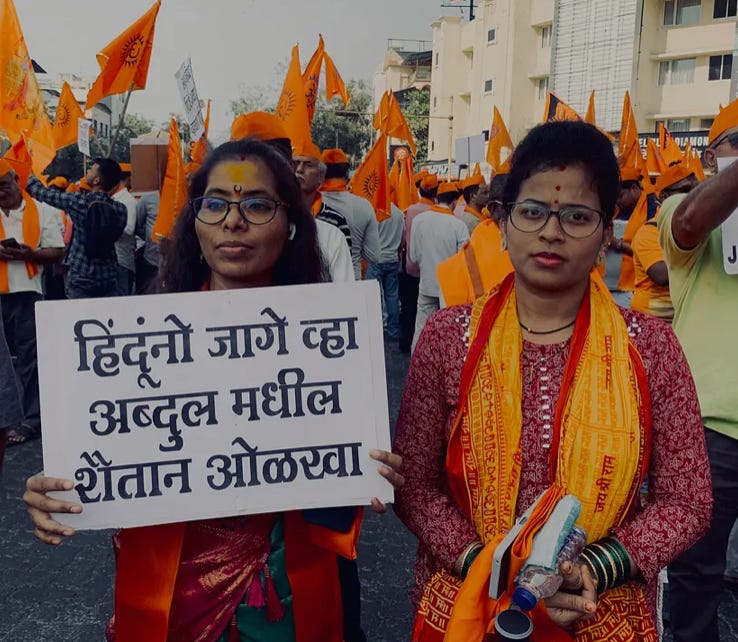To counter majoritarianism, progressive spaces in India must course-correct
We cannot effectively challenge individual acts of institutional, cultural or physical violence against the Muslim community without challenging the broader dehumanising framework at play.
It is difficult to overstate the threat facing Indian minorities in general and Indian Muslims in particular today. While the impact of decades of systemic discrimination in housing, education, salaried jobs and healthcare has been documented in the 2006 Sachar Committee report , the last ten years have seen a near-continuous onslaught on the community across the legislative, executive, and cultural spaces. All of this has been accompanied by heightened on-ground violence, and a general decline in the institutions tasked with protecting rights.
The direct legislative onslaught has included a near-total cow slaughter ban, the enactment of anti-conversion laws in multiple states (used predominantly to criminalize Muslim men in interfaith relationships), and the threat of an Assam-style national register of citizens nationwide which could result in the large scale disenfranchisement of Muslims as “illegal immigrants”. Even laws that do not specifically target Muslims on paper, such as municipal building regulations, have been selectively applied to arbitrarily demolish Muslim-owned homes and structures as collective punishment . Non-formal discrimination and violence have also intensified. While databases tracking hate crimes in India including the NCRB have stopped doing so, and others, like Hindutva Watch have been restricted from being viewed in India, everyday acts of violence against Muslims have become commonplace (there were two such instances documented in the last week in different parts of Maharashtra alone for example).
Hindu Nationalists at an anti Love-Jihad rally. Photograph by : Zaufeshan Arif
If you live in India today and do not subscribe to the Hindu majoritarian project, there is inevitably a sense of “How did we get here”. Specifically, how did a country with an ostensibly robust civil society and much-lauded institutions fail to prevent the dehumanisation of 14 percent of its population? Electoral results alone do not account for it. The answer requires some uncomfortable introspection.
Dehumanisation
In 2015, 52-year-old Mohammad Akhlaq was lynched to death in the village of Dadri by a Hindu mob that suspected him of slaughtering a cow. For the Indian media covering the incident, the focus became not on the utter inhumanity of dragging a man from his bed and killing him, but on whether the meat found in the refrigerator of the murdered man was mutton or beef. Across the ideological spectrum, this mutton or beef angle took such prominence that a probe was ordered into the meat. A judicial magistrate even ordered a First Information Report to be filed against the dead man and his family, which was later quashed as the meat in question was found to have been mutton.
In some senses, the coverage of Dadri laid the blueprint for the decade that has followed. Deploying an all-pervasive dehumanisation that casts Muslim victims as provocateurs, acts of extreme violence against Muslims are covered to highlight not the violence but what the victim could have possibly done to deserve it. The very vocabulary deployed reinforces this. Illegal demolitions and the eviction of entire families onto the street in violation of multiple court guidelines are termed “bulldozer justice”. Consensual interfaith romances and marriages are termed “love jihad”, so as to create the impression of a wholesale assault on Hindu women. Murderous mobs that attack and sometimes kill Muslims are termed “gau rakshaks” or “cow protectors” and goons who terrorise and commit violence against interfaith couples are termed “activists”.
And perhaps most cruelly, Muslim students and activists protesting the Citizenship Amendment Act (CAA) and the proposed National Register of Citizens, despite insisting on non-violent resistance, are branded seditionists and terrorists accused of “provoking” the 2020 Delhi riots. Many of these activists remain in jail today under stringent terror statutes, not convicted of any offense, but denied bail.
Culturally, the onslaught occurs at multiple levels. Bollywood, the world’s largest film industry, with an estimated global audience of 3.6 billion people, enjoys extraordinary influence over Indian popular culture. In the years immediately after independence and the partition of the subcontinent (which left an estimated 2 million people dead and 16 million displaced), this influence was used to counter majoritarian currents.
This was often done by juxtaposing the violent rigidity of religious fundamentalism over the soft complicated humanity of personal relationships. In Dharamputra (1961), for example, an illegitimate Muslim child adopted by a Hindu family grows up to be a Muslim-hating Hindu fundamentalist. The child then meets his birth family as an adult and is forced to question his own prejudice. Even films that did not directly address or challenge Hindu majoritarianism provided a humanising portrayal of Indian Muslims. Called “Muslim socials”, films like Chaudhavi ka Chand (1960) and Pakeezah (1972) were extremely popular across community lines and played their own part in preventing othering.
Today, the power of Bollywood is deployed to directly target Indian Muslims. It churns out film after film demonising Muslims based on convenient half-truths or outright lies. This ranges from blatant fear-mongering — The Kerala Story (2023) for example falsely asserted in posters that 30,000 women had been converted to Islam and trafficked from Kerala to join ISIS (fact checkers found the number to likely have been about three women in total)— to more general dehumanisation. In the recent action blockbuster Animal (2023), for example, the villain is shown to a polygamous, irrationally violent Muslim, and the hero, is a faithful practicing Hindu. On a smaller scale, an entire popular music industry has emerged devoted almost solely to the demonisation of Indian Muslims and some of the most influential young YouTubers in India thrive on creating anti-minority content .
While it is tempting to argue that this sort of reasoning is limited to the right wing in India, or is something that began in 2014, an honest look at our own spaces informs us that this isn’t true. On the contrary, the last decade has only built on and amplified prejudices and biases that existed long before 2014. In a 2021 India Today poll, a staggering 58% supported laws passed to discourage interfaith marriages. 54% believed in the existence of a widespread plot to convert Hindu women to Islam (love jihad). This is far higher than the BJP vote share in India. Multiple Muslim women have shared their experiences of being stereotyped and harassed even in ostensibly liberal spaces for wearing the hijab.
Muslim men in India have faced a long-standing battle with unjust incarceration. A 2019 report by Common Cause & Lokniti, under the Centre for the Study Developing Societies (CSDS) into police working conditions found almost 50% of the police force believed Muslims were “naturally prone to committing crimes”. In 2001, 127 Muslims attending an education seminar in Gujarat were arrested and charged with having links with terror organisations. All 127 were acquitted 19 years later. This was just one of the many such cases in that decade. The conviction rate under the UAPA (Unlawful Activities Prevention Act) is estimated to be barely 2%, and yet, this pattern has provoked comparatively little outrage outside the Muslim community. Even the assassination of human rights activist and lawyer Shahid Azmi in 2010, who spent his brief but effective career defending Muslim men unjustly incarcerated under terror statutes, did not provoke widespread notice or condemnation outside the legal fraternity at the time.
A Muslim girl sitting at Nariman Point. Photograph by Zaufeshan Arif
Civil society has not been immune to this dehumanisation of Muslims. Far too many avowedly progressive Indians also presume Indian Muslims to either be at fault for the physical and institutional violence that is committed against them, or steeped in backwardness and in need of “saving” when it comes to practices like the hijab. Operating from within this framework of dehumanisation, it is unsurprising that we have not been able to mount a serious challenge to Hindu majoritarianism. Opposition to Hindutva in this model becomes a question of degree - a morally repugnant weighing of what level of Muslim oppression we are comfortable with perpetrating. Perhaps in this model, the arrest of unknown young men living in Muslim ghettoes on false terror charges is acceptable, but the arrest of prominent students from a premier institute is not.
Or perhaps pellet guns are acceptable when used against Kashmiris but a step too far when deployed against farmer protestors in India? This sort of opposition clearly offers no meaningful resistance, as it is grounded not in principle, but in the optical comfort of the privileged in India. As we have seen over the last decade, that comfort is extremely malleable to circumstance.
The Way Forward
If we acknowledge that both politically and socially, there is a need to effectively confront Hindu majoritarianism, and I believe many well-meaning Indians across communities do acknowledge this, then what comes next is clear. We need to stop trying to challenge individual acts of institutional, cultural, or physical violence against the Muslim community without challenging the broader dehumanising framework at play.
Currently, many of us knowingly and unknowingly operate within the dehumanising framework. This happens in three major ways. First, some of us buy into the idea of a “good” Muslim. The good Muslim in the Indian liberal imagination tends to shun overt displays of faith, proclaims the superiority of the national identity over the religious one, and often culturally participates in the festivals of the Hindu majority. Nothing wrong with any of this, of course, but if we find ourselves instinctively offering this Muslim more solidarity than a Muslim who adheres more strictly to their faith, wears the physical markers of their religion, and speaks primarily to and for their community, it is time to introspect on why. Specifically, how do we begin to challenge the idea of a majoritarian state if we ourselves cannot provide cultural space for minorities to express themselves freely?
Second, some of us try to counter the majoritarian dehumanisation of Muslims as “violent” by altering Muslim behavior instead of challenging the dehumanisation head-on. In this framework, we hold Muslims to standards for their speech and expression that no other community is held to. Any expression of Muslim anger, no matter how mild, is seen as potentially pushing more Hindus towards majoritarianism and is censured, often more than the cause for the anger. This is particularly painful as it effectively blames Indian Muslims for their own dehumanisation and doubles down on them to police the tone of their resistance.
Third, we refrain from offering direct solidarity to the Muslim community. We choose to focus on more abstract and “neutral” ideas like an effective judiciary, or the constitution of the country. Many of us do so with the best possible intentions - perhaps we think we will be able to convince more people this way, as it does not require them to challenge their existing prejudices. We seek to apportion blame between the victims and perpetrators of violence in the hope of being seen as “objective” or “neutral”. What we do not perhaps realize is that refusing to challenge the dehumanisation head on, only serves to reinforce it. If a community is being demonised, it doesn’t help to say “Well even demons should have legal rights”, we need to challenge the demonisation itself.
To do all of this requires us to confront our own prejudices and listen to the targets of such dehumanisation with clear and open minds. This may not be a gratifying process but it is essential. If the world over the last five months has taught us anything, it is that there is no natural end point to a cycle of dehumanisation, and that once people are dehumanised, there is no end to the horrors that can be perpetrated against them. Resisting this, and resisting it effectively, is imperative.
Sarayu Pani is a lawyer and tweets at @sarayupani






